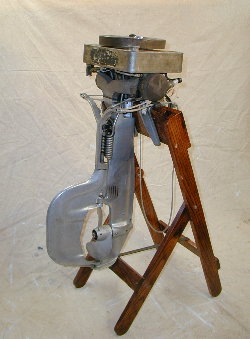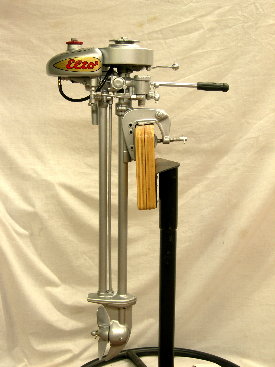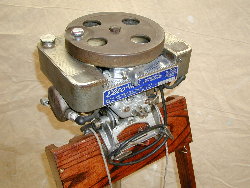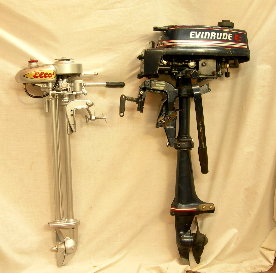
|
Elto
Ole Evinrude sold the Evinrude outboard business in 1913 due to health issues. After a few years of rest and retirement he started his second company Elto (Evinrude Light Twin Outboard) in 1921. Almost overnight he was second only to Johnson in production - handily outselling his old company Evinrude. Eventually he would buy his original company back and his son Ralph would go on to purchase Johnson out of bankruptcy and form the Outboard Marine Corporation (OMC). Unfortunately by the 1940's Elto was reduced to a "value" brand and, after being relegated to Canada, gone by the mid 1950's. A sad end since Elto's start was so promising. The motor that built Mr. Evinrude's second outboard career is the "silvery" Elto that has become known as the Ruddertwin. The motor is stationary and the boat is turned by using a rudder much like an inboard vessel. Cooling is by water forced in the rudder and up to the powerhead. Ignition is via battery and an Atwater-Kent timer under the flywheel. Fuel is supplied by a poppet style mixing valve, not really a true carburetor. The Elto is started by opening the fuel valve, setting the timer to "Stop" and holding the poppets up while rocking the flywheel a few times - this primes the motor. Set the timer to "Start" and rock the flywheel in the opposite direction to its travel (you rotate it anti-clockwise, it starts and runs clockwise). More often than not the motor will start! An Elto Ruddertwin in good tune is remarkably easy to start and incredibly reliable. A plus is that the Ruddertwin also has reverse - while the motor is running simply advance the timer to "Reverse" and press the stop button. As the motor winds down release the stop button and 60% of the time you are in reverse. (If not timed correctly you will now be running full throttle forward!!!)
About the Outboards of 1926: Since the Elto is so different in design from the other four 1926 outboards, there was a lot of head scratching as to how it would compare. The writer must confess to being extremely prejudiced in favor of the Johnson Model A-25 Light Twins having years of experience with them. (Johnson's were the #1 seller in 1926 - so the buying public must have agreed with us!) The first time this Elto was run it became obvious why they were so popular - it is a fabulous (if unconventional) outboard. My impressions so far are as follows: 1) The Elto Ruddertwin starts very easily, runs well and is extremely well engineered and built - it offered a lot of value for the dollar. Of the 5 motors, it is the most fun to run since starting it with the knob and steering with the ropes is so unconventional, plus the underwater exhaust is quiet and almost fume free. It is a bit heavy and I've found the reverse function unpredictable AND not having a tilt lock is a problem since the motor kicks up in reverse! 2) The Lockwood is the most powerful and fastest motor of the bunch. It's reasonably light and mechanically straight-forward. Despite the above water exhaust, it isn't too loud but it can get smoky! It's shortcomings are that you can't tilt it very far without the carb hitting the transom clamp (and breaking it off!) and, because of the cooling water pipe, you can't swivel it 180 degrees for reverse. (Johnson claimed to have patented that feature) I would also like to have some kind of carrying handle or place to grab it. Being the most powerful of the bunch it also goes through the most fuel. 3) The Johnson A-25 is light, portable and has a reliability record second to none. It's exceptionally well engineered, made from quality materials, easy to work on and use - plus it has 180 degree reverse and a lock to prevent it kicking up, both handy features. It is rated at only 2hp and the smallest of the bunch, so it's not fair to compare speed with the Lockwood, Elto and presumably the Caille. (However, it is faster than the Evinrude rated at 1/2hp more!) The above water exhaust can be a little loud and smoky - the water pump check valves also periodically stick causing it to overheat. Last Place) The Evinrude Model N that I had was definitely the bottom of the pack; fussy, heavier than the Johnson and less powerful. There is no advantage to the "battery ignition" option and the map light/generator only causes issues with the magneto. That swiveling lower unit is odd, but it does work. I found (when it ran) the N was the loudest of these motors. I hope to find a '26 Caille Pennant so I will be able to compare it to the others - my expectation is high for it! The criteria I used to evaluate the motors is as follows::
Elto Cub During the depression Evinrude, like most everyone, was faced with hard times. The entire Evinrude company pitched in and everyone gave up something to help keep the doors open - many weeks it was hand-to-mouth. (Can you imagine workers giving up paychecks today so their company could keep the doors open?) This, reportedly is what happened and Evinrude was able to stay in business while others folded. Part of what kept the doors open was the introduction of low priced items that could be purchased with the scant extra dollars available. Camp stoves, bicycles and lawnmowers were just some of the products Evinrude sold to keep their skilled workers on the job and dollars coming in. And the low-priced outboards they offered were not junk but good solid motors that would lay the foundation of Evinrude brand loyalty for better times. By the late 1930's with Evinrude, Johnson and Elto all under OMC, the Elto brand was relegated to the low-cost tier. And the lowest priced outboard motor offered was the minute Elto Cub. At only $26.50 and 1/2 horsepower, it was the smallest, lightest and least expensive outboard motor ever offered by OMC. The Cub seen here was given to me by a family friend, it was his as a boy back in the 1940's. I went to great pains to try and restore it to look as it did when it left the factory in 1940. (see tips on the restoration below the photos)
Cub Restoration Restored Elto Cubs (and their fancy sister the Mate) are pretty common at AOMCI meets - but I have noticed that very few are put back to the way they originally looked. By choice or ignorance, many owners favor polishing and customizing them using and array of different colors and sometimes even modifying them by shortening or making "unique" custom components. While each owner is free to do what he or she wants with their motor, it has gotten to the point where people may think these outboards were originally supposed to be all shiny and painted with vibrant colors! When I restored my Cub, I really wanted it to look as close to the way it left the factory as possible. I thought I would share my observations here on www.oddjobmotors.com in case anyone is contemplating a restoration of one of these motors back to its original look. To do the homework for my restoration I photographed 10 original examples of the Cubs in several AOMCI member's collections. The nicest one I found was part of Bob G's collection and was close to pristine. All of the original examples were entirely painted dull aluminum from flywheel to prop-nut, almost as if they were dipped into a paint bath as they came off the line! The items I noted that were not painted appear to be the following;
There are a number of differences in the Starting & Oiling instructions between the OE ones I photographed. The difference is how the words flow between the left & right halves of the decal and a slight change in the font. Most of the S/O decals were black type on a silver (or clear) background but 3 of the S/O decals had a gold colored background. Originally I thought this was due to aging but from discussions with other members it appears the gold was used on the later motors as part of the background color. None of the reproduction decals available when I restored my motor were exactly true to the original decals observed, all used different fonts and spacing. (NOTE: Subsequently AOMCI Member Denny Cole has produced a decal that is just about a perfect match.) It is hard to tell but it is possible the original ELTO and PAL decals were printed on a continuous strip, not in 3 pieces as provided by many of the current suppliers. It is also possible that there was a protective "varnish" that was applied in a band around the tank that with 60+ years of aging makes it appear to be a continuous strip. All of the original motors had the Elto decals placed haphazardly and in slightly different positions. Some with the leading edge of the Elto decal wrapped around the tank corner and a few with it centered on the side of the tank. Most of the Elto decals appear to have the same red font with black outlining on a gold background but two (both with 1940 serial #'s) had a greenish colored background. (It has been speculated that the gold background turned green with age on these two examples) All of the motors I've seen had a red gas cap with the vent knob natural aluminum. It appeared that most of the 1939 examples had plastic caps while the 1940+ motors had painted aluminum gas caps - but there were two exceptions where later (1941) motors had plastic caps. Those are my thoughts on the Cub restoration. If your motor is a nice original I encourage you to keep it that way! If you are cosmetically restoring one, please try to respect the Elto legacy and make it as close to the original look as possible. Atco Boatimpeller | Bendix | British Seagull | Caille | Champion | Chris Craft | Dragon Fly | Elgin | Elto | Evinrude | Flambeau | Johnson | Lauson | Lockwood Ash | Mac10 Wankel | Martin | Mercury | Misc.Motors | Oliver | Outboard Jet 200 | Pluvier | Scott-Atwater | Tohatsu | Tomos | Volvo | West Bend | Whirlwind(Soviet) | Wizard| Yamaha | Zundapp |
||||||||||||||



